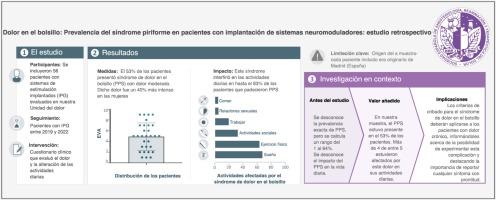Un dolor de bolsillo: prevalencia de dolor en los pacientes con implantación de sistemas de neuromodulación: estudio retrospectivo
IF 0.9
Q3 ANESTHESIOLOGY
Revista Espanola de Anestesiologia y Reanimacion
Pub Date : 2024-11-01
DOI:10.1016/j.redar.2024.02.001
引用次数: 0
Abstract
Introduction
Implantable pulse generator (IPG) is a neurostimulation therapy mediated by electrodes and surgically implanted in a subcutaneous “pocket” used for the control of numerous pathologies. This study examines both the prevalence of pain associated with IPG implantation (“pain pocket syndrome”) and its associated characteristics.
Materials and methods
56 patients with an IPG were included in the study. A health questionnaire was conducted to determine the presence of pain associated with the pocket and its neuropathic characteristics, as well as associated aesthetic concerns, location, situations that accentuate or alleviate pain, medications used for baseline and pocket pain control and other factors associated.
Results
Pain in the area of implantation of the IPG had a prevalence of 52.6% of patients (n = 27), in our sample, with a mean score on the visual analogic scale (VAS) of 4.9 points [3.9 - 5.8 points], with neuropathic characteristics in 53.3% (n = 16) of the patients with pain, with differences between the mean VAS score of the female (5.5 [4.3 - 5.8 points]) and males (3.5 points [2.1 - 4.9 points]) (P=.04).
Conclusion
Pocket pain is a condition with a higher prevalence than described in previous studies, being of a higher intensity in females, involving a moderate pain in the area of implantation of the neuromodulating therapy. This pain has neuropathic characteristics and could require a repositioning intervention. Hence, more studies in this field should be carried to detect and prevent this syndrome.

袖珍疼痛:植入神经调控系统患者的疼痛发生率:一项回顾性研究。
导言植入式脉冲发生器(IPG)是一种由电极介导的神经刺激疗法,通过手术植入皮下 "口袋",用于控制多种病症。本研究探讨了与 IPG 植入相关的疼痛("口袋疼痛综合征")的发生率及其相关特征。研究人员进行了健康问卷调查,以确定是否存在与牙槽袋相关的疼痛及其神经病理性特征,以及相关的美学问题、位置、加重或减轻疼痛的情况、用于控制基线和牙槽袋疼痛的药物及其他相关因素。结果在我们的样本中,52.6%的患者(n = 27)在植入 IPG 的区域出现疼痛,视觉模拟量表(VAS)的平均得分为 4.9分[3.9 - 5.8分],53.3%的疼痛患者(n = 16)具有神经病理性特征,女性(5.5分[4.3 - 5.8分])和男性(3.5分[2.1 - 4.9分])的平均VAS评分存在差异(P=.04)。04)。结论口袋痛是一种发病率高于以往研究的病症,女性发病率更高,神经调节疗法植入区域有中度疼痛。这种疼痛具有神经病理性特征,可能需要重新定位干预。因此,应在这一领域开展更多研究,以检测和预防这种综合征。
本文章由计算机程序翻译,如有差异,请以英文原文为准。
求助全文
约1分钟内获得全文
求助全文
来源期刊

Revista Espanola de Anestesiologia y Reanimacion
ANESTHESIOLOGY-
CiteScore
1.80
自引率
15.40%
发文量
113
审稿时长
82 days
 求助内容:
求助内容: 应助结果提醒方式:
应助结果提醒方式:


